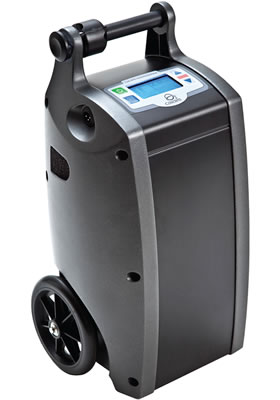Product Spotlight
Keeping Tabs
An upgrade on a familiar POC could redefine how providers provision portable oxygen.
- By David Kopf
- Dec 01, 2014
 Do you know where your portable oxygen concentrator is? That’s a question that could very well keep some providers up at night if they realized how much money they might have devoted to portable oxygen technology that winds up in the hands of patients that aren’t all that portable.
Do you know where your portable oxygen concentrator is? That’s a question that could very well keep some providers up at night if they realized how much money they might have devoted to portable oxygen technology that winds up in the hands of patients that aren’t all that portable.
This was the dilemma that sparked some inspiration at POC manufacturer O2 Concepts. The company’s Oxlife Independence is a well-known POC offering that has served up a solid portable oxygen therapy package for more than two years, but a new upgrade aims to put a considerable amount of telemetry intelligence into providers’ hands.
“Telemetry? Why telemetry?” the casual observer might well wonder. Telemetry usually finds its applications in the realm of remote utilities management or long-haul trucking, but there are actually some good reasons for using this kind of technology when it comes to respiratory care. For starters, there is the issue of a delicate and costly POC winding up getting provisioned to a patient that, contrary to the ambulation goals of portable, long-term oxygen therapy, simply decides to stay at home for whatever reason. In that case, some on-board telemetry technology, such as GPS and wireless data, could help the provider identify this point of inefficiency and work with the physician to outfit that user with something more within his or her needs.
“Remote maintenance checks were another use that were quite popular,” explains Rob Kent, president and CEO of O2 Concepts. “Instead of having to send a driver out to check on a machine every so often, you can do that remotely.”
So how has O2 Concepts gone about adding this technology to the Oxlife Independence? The company calls it a “DNA Upgrade.” In other words, the upgraded Oxlife Independence looks the same in all respects, but it has changed inside. The internals of the device have been altered to accommodate GPS and wireless data technology. Getting all that new capability to fit in the same form factor — let alone work right — requires changing things right down to the logic board. Hence the term, “DNA Upgrade.”
“For a piece of equipment like ours, it’s always hard to do the new board layouts, where you incorporate all the new equipment, such as antennas, on it,” Kent explains. “So that was it, but it was also getting the machines to get good reception. We had to really dial in the kind of material we were using for the side panels and make sure the we could get the technology in the machine, without having to put a big, bulk antenna on it.”
Of course, the device has to use a network, and O2 Concepts has decided to partner up with Verizon, but hasn’t made any firm decision in terms of the network services that will be used. Ultimately, the goal is to keep this capability low-cost, Kent says.
“It’s not that much data,” he explained. “You’re talking about sending text string back and forth, so we were able to go with a minimum plan of one megabyte a month for these machines. It typically winds up costing about one to two dollars to service those contracts.”
In terms of how that price is paid, whether through a subscription service or incorporated into the price of the unit, is still up in the air, and Kent says O2 Concepts is talking to the provider market to get feedback.
“I think people are going to want to figure out how much they want to use the machines,” he says. “So the technology is something that we can embed, and we can reach out and turn a group of machines on and start a subscription, or we can turn them off. So, we’ll probably wind up doing monthly subscriptions for he data.”
The newly upgraded POC has undergone O2 Concepts’ internal testing procedures, and Kent says that now the big effort is to get the device to go through certifications.
“We’ve done quite a bit of testing,” he explains. “Now we’re in the phase where we have to get certified on the Verizon network, and we have to do our supplemental 510(k)s on the product, and those are going to be relatively easy steps.”
In terms of availability, the Oxlife Independence with DNA upgrade will become available to current O2 Concepts customers sometime between March and April, and be available market-wide in the latter half of 2015.
Apart from the DNA Upgrade, the Oxlife Independence is the same POC users know: It offers continuous flow up to 3LPM and pulse settings up to 6 (96 mL), and the POC can be used for both in-home and portable continuous flow. The upgraded device will still feature O2 Concepts’ ESA Technology for long battery life (5.75 hours at 2 pulse at 20 bpm and 2.5 hours at 2LPM continuous), and dual battery bays let patients can hot-swap batteries while the device is running. The Oxlife Independence is FAA approved for air travel, and comes with a five-year warranty.
Oxlife Independence
02 Concepts LLC
www.o2-concepts.com
(877) 867-4008
This article originally appeared in the December 2014 issue of HME Business.
About the Author
David Kopf is the Publisher HME Business, DME Pharmacy and Mobility Management magazines. He was Executive Editor of HME Business and DME Pharmacy from 2008 to 2023. Follow him on LinkedIn at linkedin.com/in/dkopf/ and on Twitter at @postacutenews.